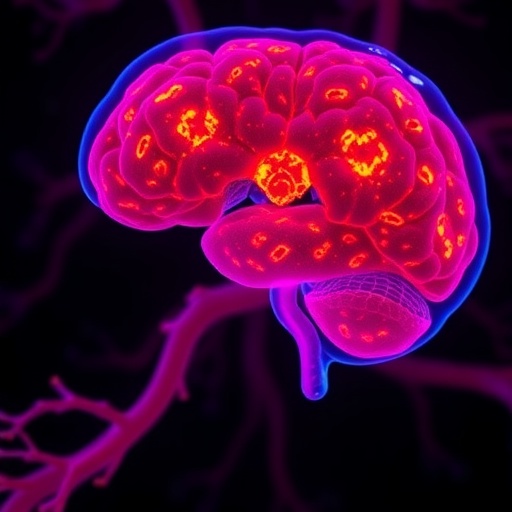In a groundbreaking development that could redefine the study and treatment of autoimmune diseases, researchers have successfully modeled T cell-mediated autoimmune pituitary disease using human induced pluripotent stem cell (iPSC)-derived organoids. This pioneering approach provides an unprecedented window into the complex immune interactions targeting the pituitary gland, a vital regulator of endocrine function. The study, led by Kanie and colleagues and published in Nature Communications, leverages cutting-edge stem cell technology to replicate key aspects of pituitary autoimmunity in a human-relevant three-dimensional tissue model.
The pituitary gland, often termed the “master gland,” orchestrates a multitude of hormonal cascades that govern growth, metabolism, stress responses, and reproductive functions. Dysfunction caused by autoimmune attack against pituitary cells, termed autoimmune hypophysitis, can result in devastating endocrine deficits and systemic symptoms. Historically, studying this autoimmune process has been constrained by the lack of suitable human models. Rodent systems, while valuable, fail to fully recapitulate human pituitary biology and immune interactions. This shortfall has hampered the understanding of immune mechanisms as well as the development of precision therapeutics.
The researchers began by generating pituitary organoids from human iPSCs, a technology that reprograms adult cells back into a pluripotent state, capable of differentiating into any cell type. These organoids were engineered to mimic the cellular diversity and microarchitecture of the human pituitary gland. Importantly, the system supported the survival and functional maturation of hormone-producing cells, reflecting the gland’s critical endocrine roles. This represented a substantial advance, as earlier two-dimensional cultures lacked physiological relevance for complex immune modeling.
To simulate autoimmune attack, the team introduced T cells sensitized to pituitary autoantigens into the organoid cultures. These autoreactive T cells are central drivers of autoimmune disease in patients, mediating tissue damage through direct cytotoxicity and cytokine release. The model captured hallmark features of autoimmune hypophysitis, including infiltration of immune cells, disruption of hormone-producing cell populations, and inflammatory signaling cascades. The investigators meticulously characterized these immune-endocrine interactions using single-cell RNA sequencing, immunofluorescence imaging, and functional hormone assays.
One of the most striking findings was the demonstration that autoreactive T cells selectively target specific pituitary cell subtypes, consistent with patterns observed in patients. This subtype specificity underscores a precision element of autoimmune pathogenesis that was previously difficult to dissect in bulk tissue studies. Furthermore, the organoid model revealed dynamic cytokine networks that amplify tissue injury and perpetuate inflammation, illuminating potential signaling nodes for therapeutic intervention. These insights deepen the mechanistic understanding of how T cell autoimmunity destabilizes endocrine homeostasis.
The study’s integration of cutting-edge technologies enabled a multi-layered analysis of immune-mediated pituitary pathology. By leveraging human iPSC-derived organoids, researchers bypassed species differences inherent to animal models and accessed a tractable system amenable to genetic manipulation and drug screening. This paradigm is poised to accelerate discovery in autoimmune endocrinology by providing a scalable, reproducible platform to test how genetic, environmental, or pharmacologic factors modulate disease progression.
Implications for clinical translation are profound. The platform offers a new avenue for identifying biomarkers that predict susceptibility or monitor disease activity in autoimmune hypophysitis. Moreover, candidate therapeutics targeting autoreactive T cell pathways or inflammatory mediators can now be evaluated in a human-tissue context before advancing to costly clinical trials. This humanized in vitro system bridges a critical gap between mechanistic research and patient care, heralding a new era of precision medicine for autoimmune pituitary disease.
Beyond pituitary autoimmunity, this study exemplifies the promise of organoid models to dissect immune pathologies affecting other endocrine organs, such as the thyroid, adrenal glands, or pancreatic islets. As autoimmune disorders frequently present overlapping immune features, insights gained here may inform common mechanisms and foster the development of broad-spectrum immunomodulatory strategies. The research community anticipates that this modular organoid platform will inspire similar approaches across multiple autoimmune specialties.
The implications of this research extend into the realm of drug discovery and immunotherapy. The organoid platform enables high-resolution evaluation of candidate agents aimed at modulating T cell activation, cytokine production, or protective regulatory mechanisms. For example, blocking specific costimulatory pathways or using checkpoint inhibitors could be tested for efficacy in reducing destructive immune responses without broadly suppressing immunity. Such precision targeting offers hope for treatments that preserve pituitary function and improve patient quality of life.
Furthermore, the study sheds light on the interplay between genetic susceptibility factors and immune triggers. By integrating patient-derived iPSCs harboring distinct genetic backgrounds into the organoid system, researchers can explore how individual variability influences autoimmune risk and progression. This personalized modeling approach promises to unravel the complex gene-environment interactions underlying pituitary autoimmunity and to facilitate the development of tailored therapeutic regimens.
From a broader perspective, this research signifies a paradigm shift in modeling human diseases. The convergence of stem cell biology, immunology, and bioengineering has enabled recreation of intricate tissue-immune dynamics previously accessible only in living organisms. As these technologies mature, similar organoid-immune co-culture models will become indispensable tools across biomedical research, enabling rigorous mechanistic studies that translate directly to clinical innovation.
In summary, Kanie et al.’s innovative use of human iPSC-derived pituitary organoids coupled with autoreactive T cell modeling offers a transformative new method to study autoimmune hypophysitis. By faithfully recapitulating human disease processes in vitro, this platform opens exciting avenues for dissecting pathogenic mechanisms, discovering biomarkers, and developing highly specific therapies. The research heralds a new frontier where complex autoimmune disorders can be understood and treated with unprecedented precision, bringing hope to patients suffering from debilitating pituitary autoimmune diseases and beyond.
Subject of Research: Modeling of T cell-mediated autoimmune pituitary disease using human induced pluripotent stem cell-derived organoids.
Article Title: Modeling of T cell-mediated autoimmune pituitary disease using human induced pluripotent stem cell-originated organoid.
Article References:
Kanie, K., Ito, T., Iguchi, G. et al. Modeling of T cell-mediated autoimmune pituitary disease using human induced pluripotent stem cell-originated organoid. Nat Commun 16, 7900 (2025). https://doi.org/10.1038/s41467-025-63183-x
Image Credits: AI Generated
Tags: autoimmune disease study limitationsautoimmune hypophysitis modelingendocrine function researchgroundbreaking research in immunologyhormonal regulation and dysfunctionhuman-induced pluripotent stem cellsimmune interactions in pituitary diseasepituitary gland organoidsprecision therapeutics developmentstem cell technology advancementsT cell-mediated autoimmune diseasethree-dimensional tissue models





